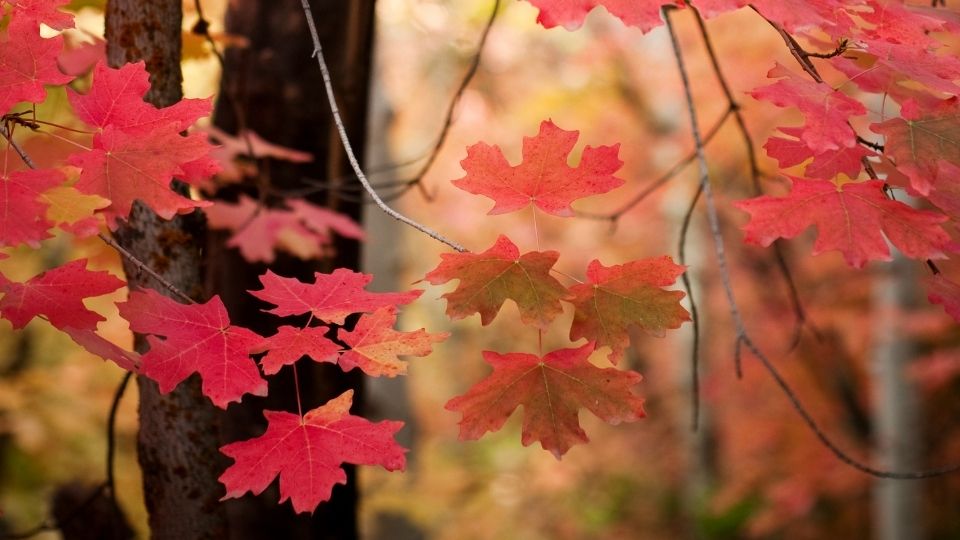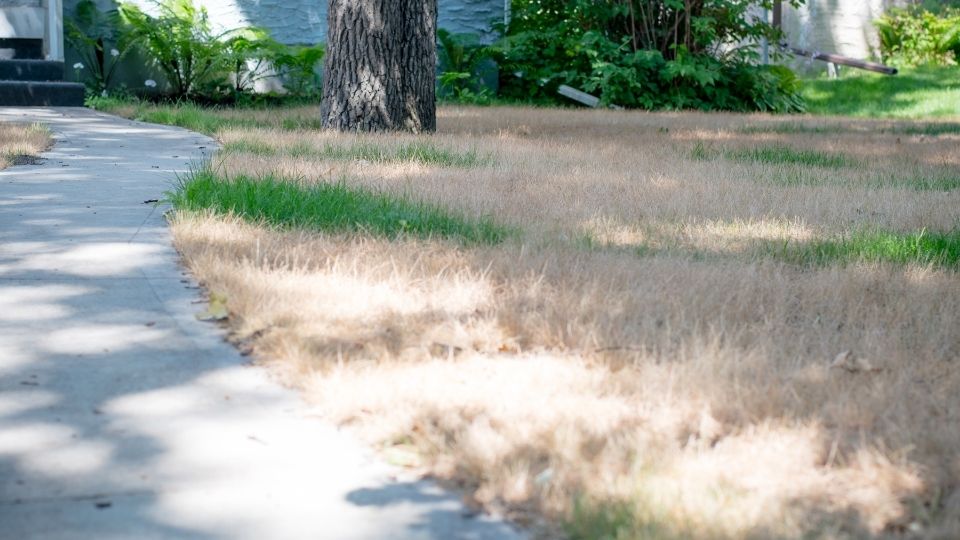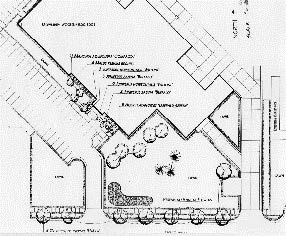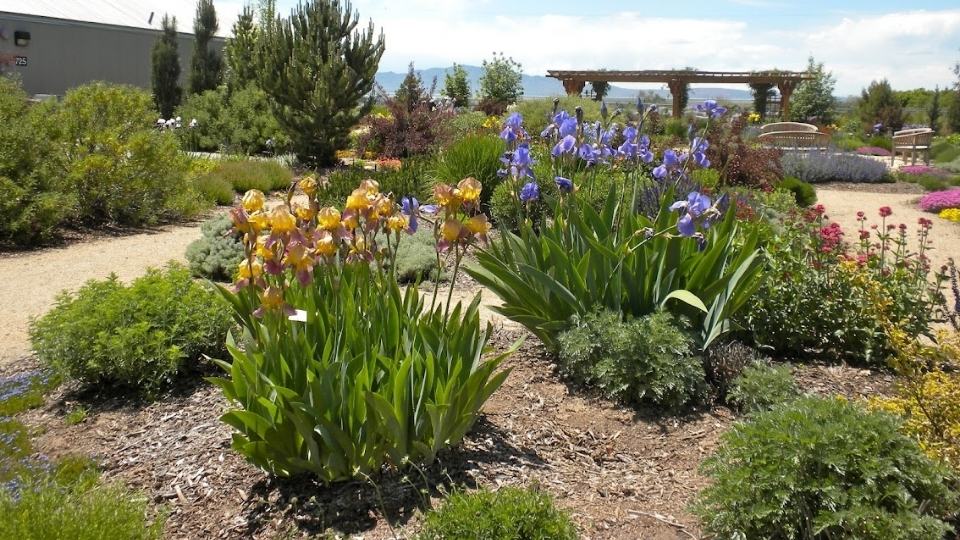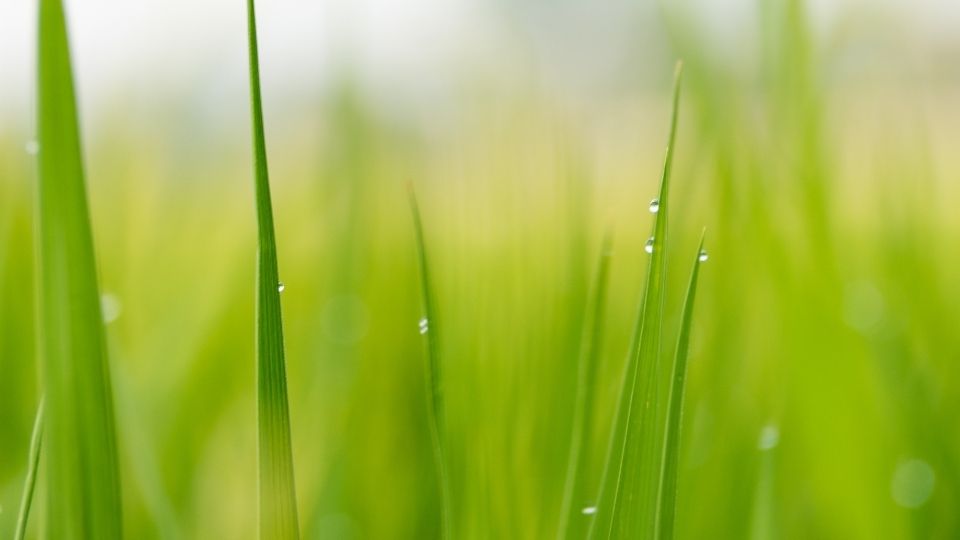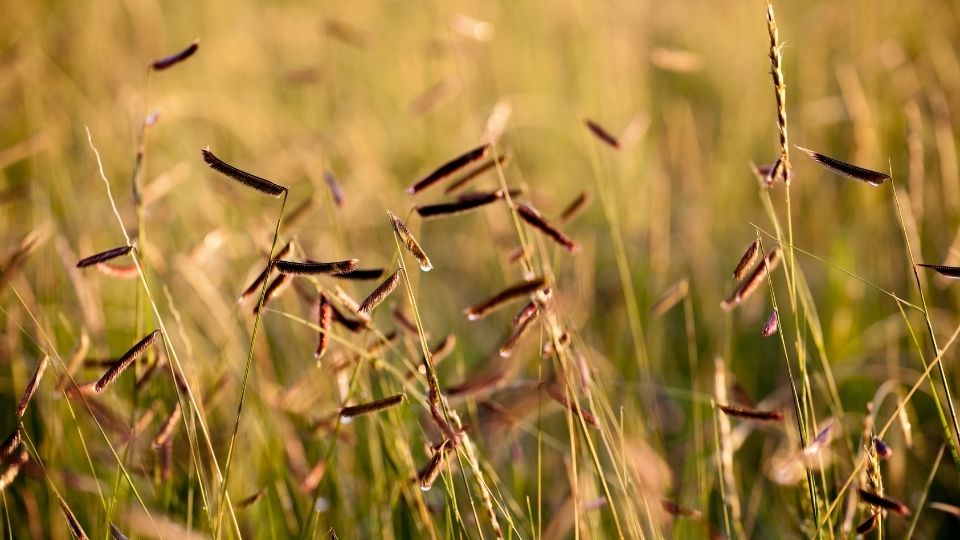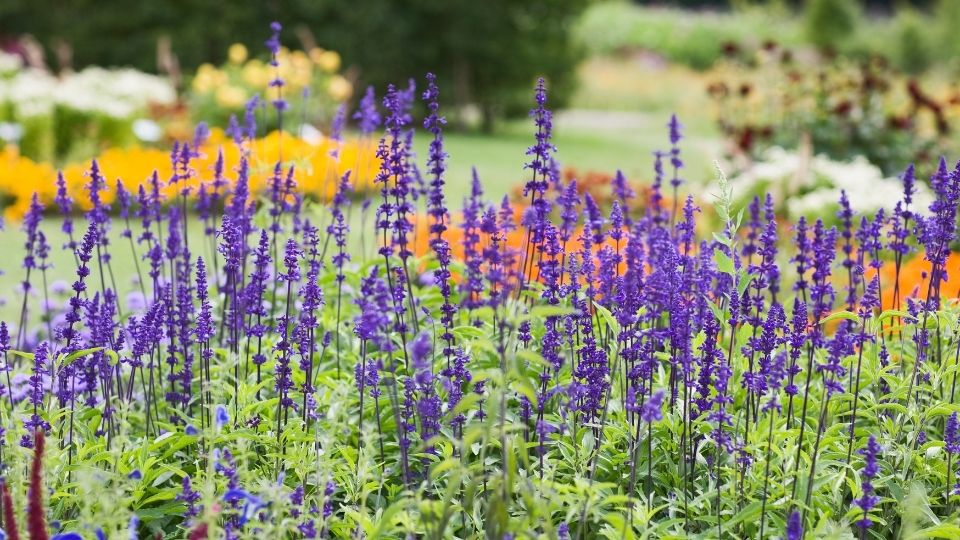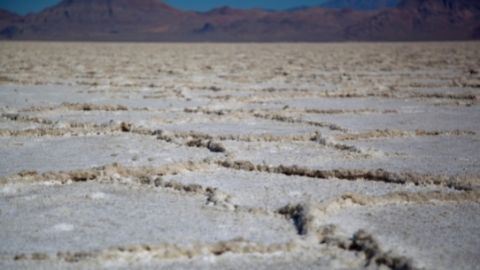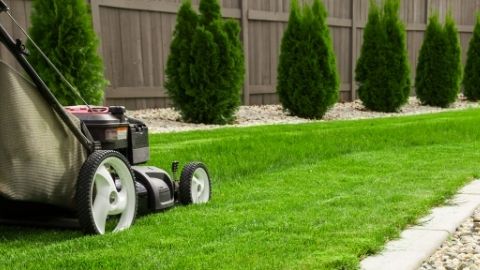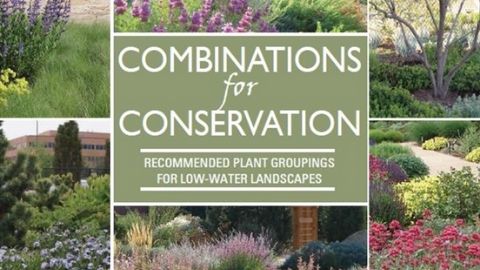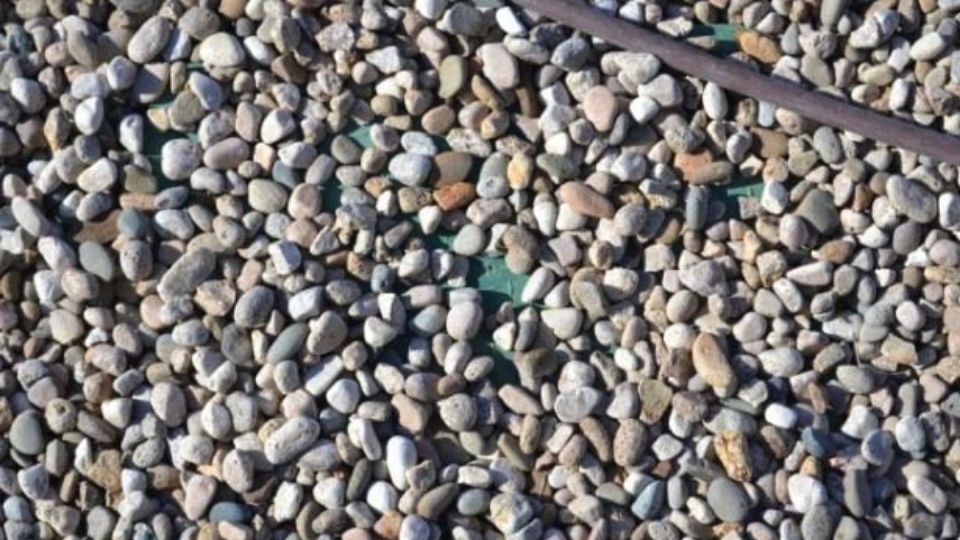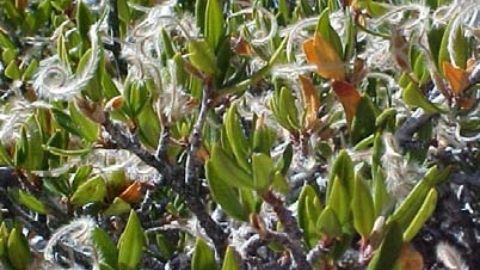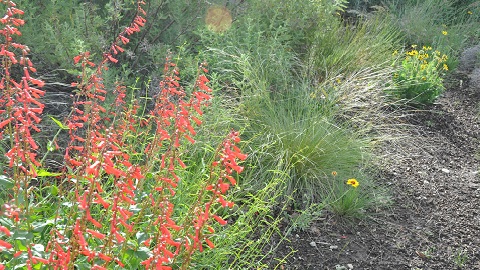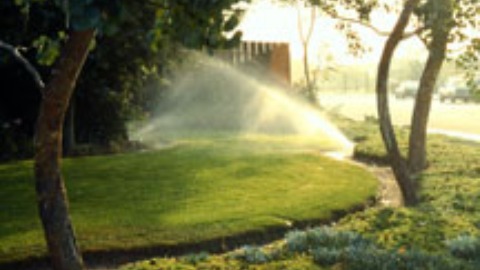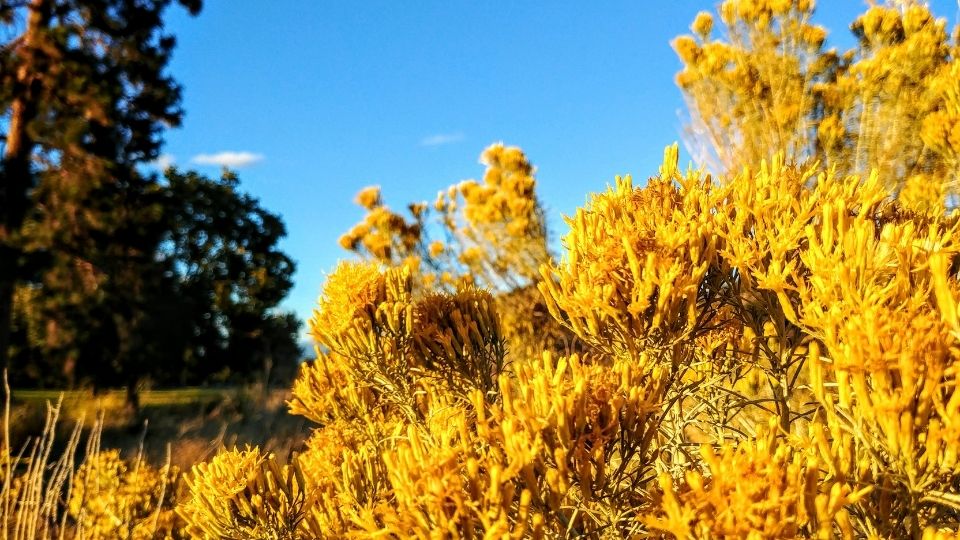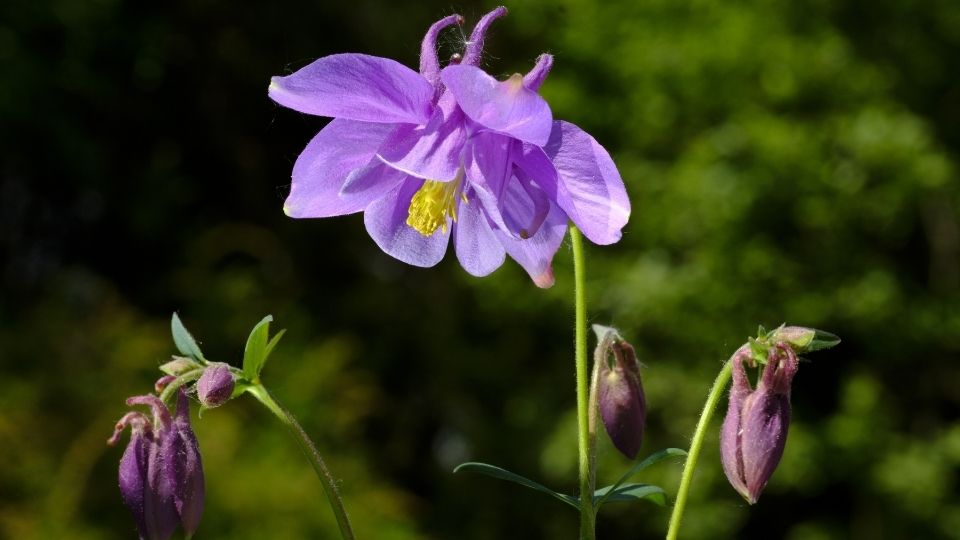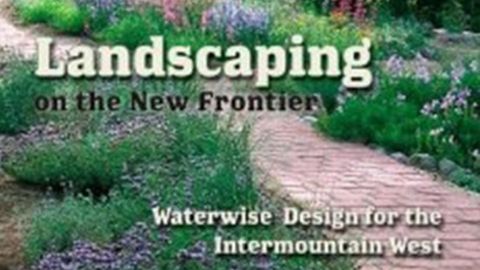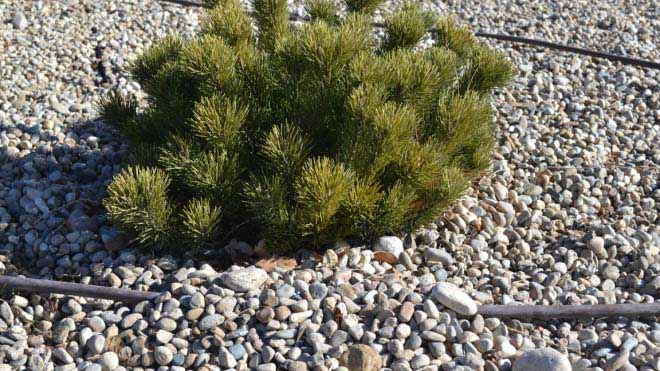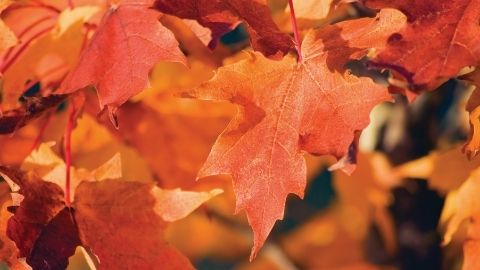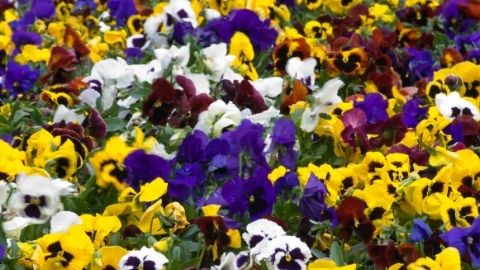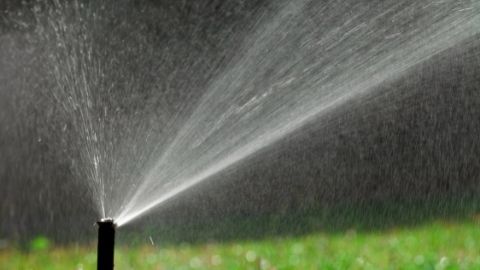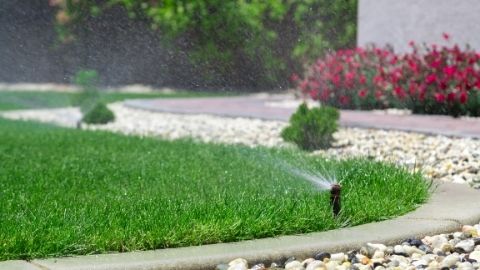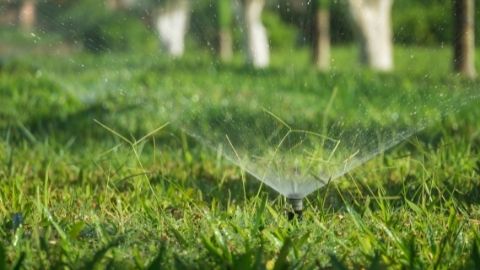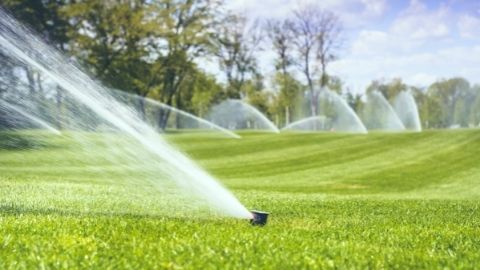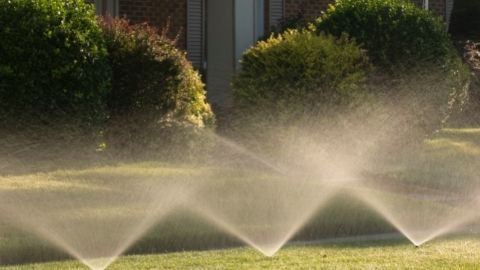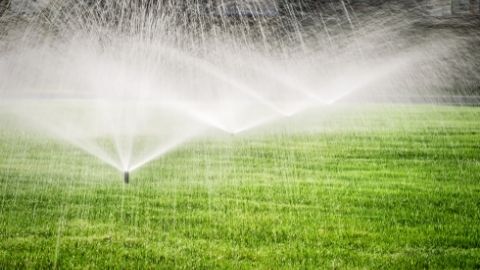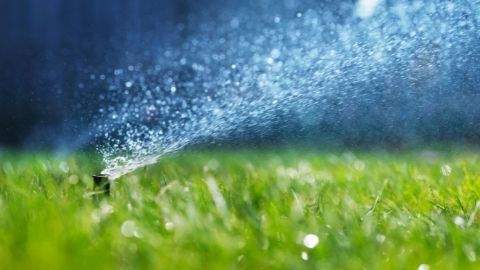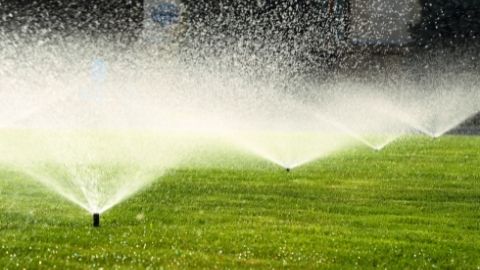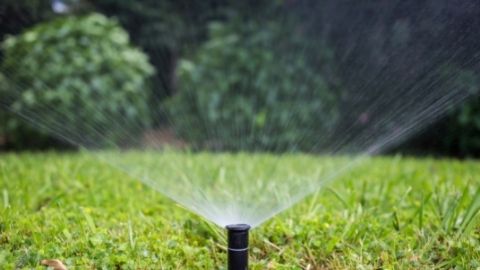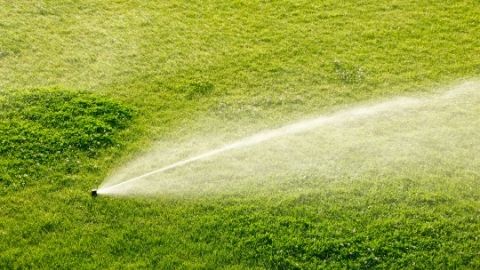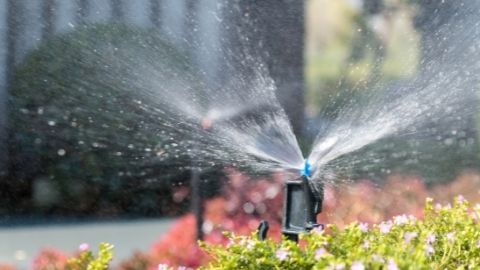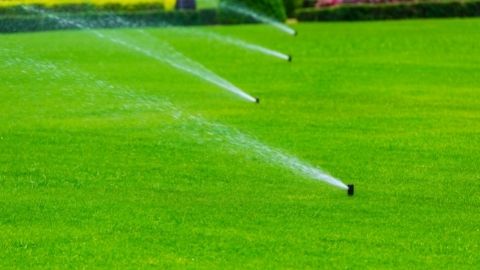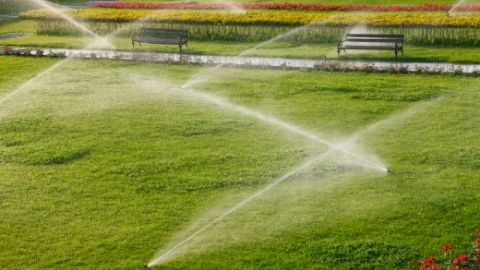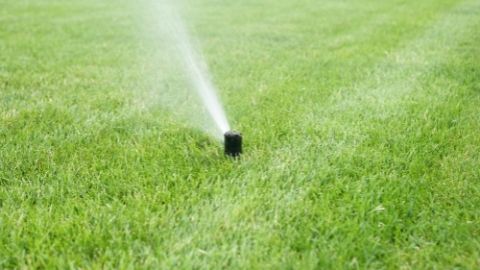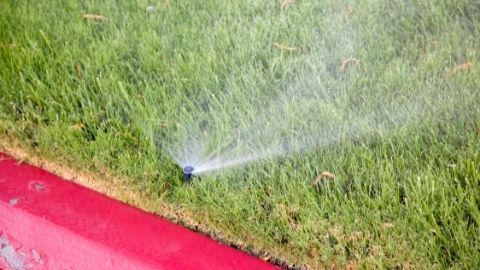Transitioning Trees from Traditional to Low-Water Landscapes
In a drought situation, landscape managers may be required or feel a need to remove turfgrass from an existing landscape. The illustration below shows a landscape where turfgrass has been replaced with boulders, shrubs, and gravel mulch while preserving the existing tree. Tree survival under these conditions requires specific construction and management practices.
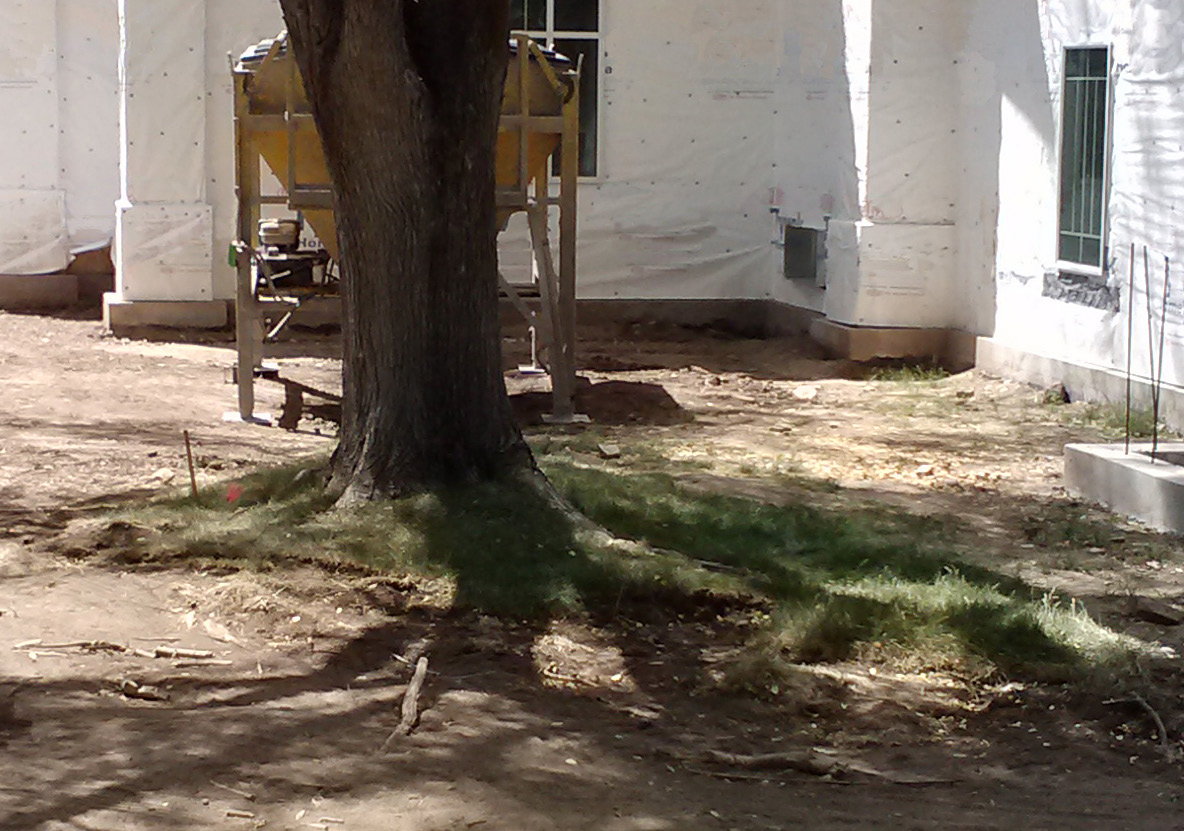
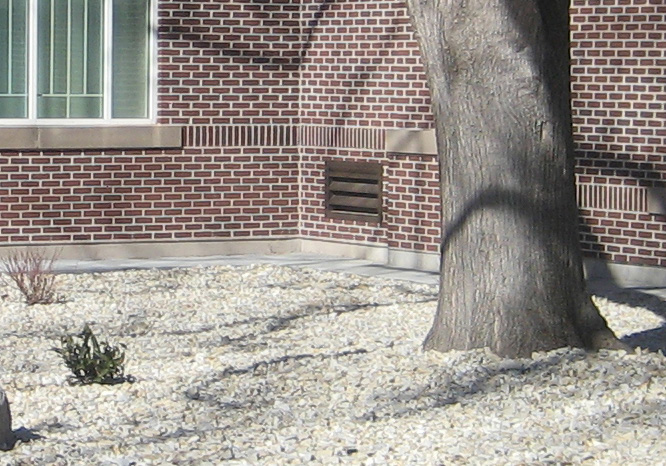
Effective Remodeling Construction
Remodeling an existing landscape provides a rare opportunity to create an improved landscape while keeping valuable trees. Therefore, it is important to get it right. Steps to follow include:
Landscape Design
- A new plan for the landscape should be designed that clearly shows plants to be retained as well as those that will be removed.
- Any new plants added near trees should be selected based on compatibility with the tree and its environment.
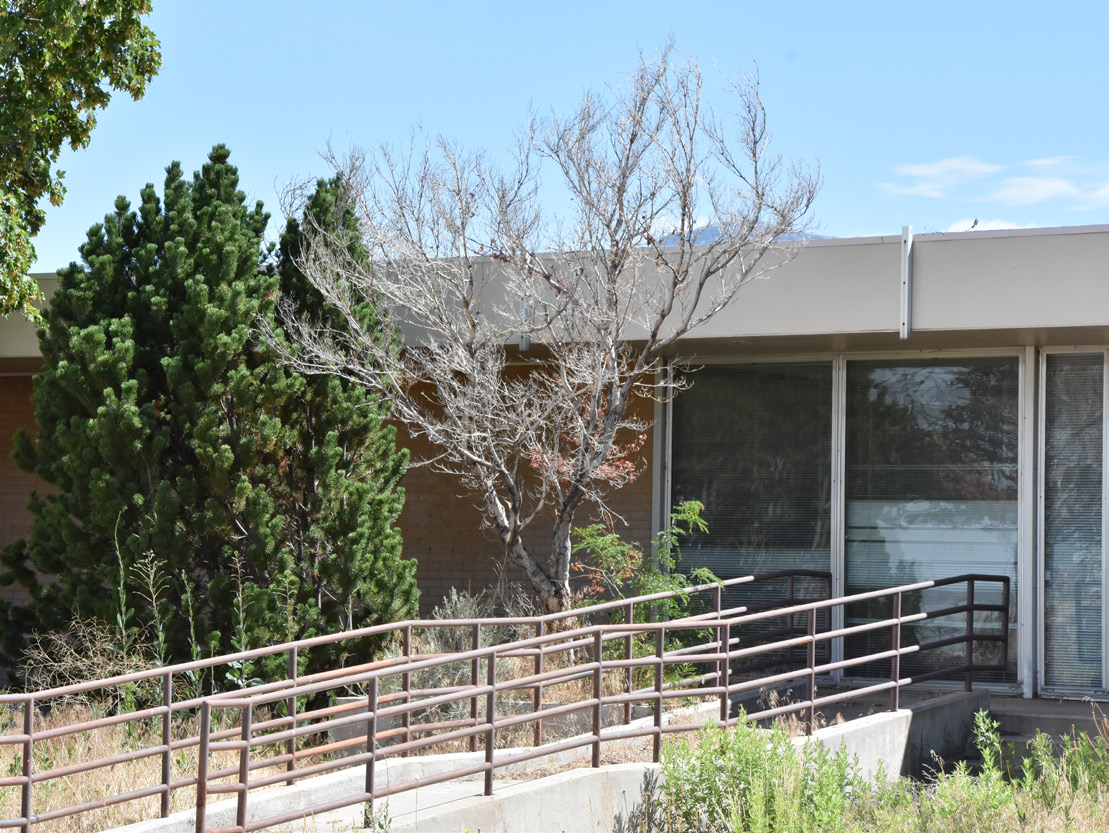
than the (now dead) Japanese maple. Irrigation should have
been managed to meet the greater water need of
the maple.
Irrigation
- A new irrigation plan should be drawn and upgraded to an as-built plan upon completion of the project. It should show where lines, wiring, heads, and valves are located
- Transitioning from turfgrass to just trees with mulch may allow additional water conservation through the use of drip or microspray irrigation. Drip irrigation systems should cover mulched areas while not wetting tree trunks.
- New plants should match the irrigation requirements of existing trees in the same irrigation zone. If existing trees have different irrigation needs than other retained material, the irrigation system should be changed to allow separate hydrozones and independent irrigation (Fig. 2).
- The root systems of large trees are very likely to extend beyond their drip line. As such they may access water from adjacent turf areas, hardscaping runoff, or even ground water. Irrigation management should reflect all sources of water available to the trees.
Soil Management
- Determine the soil type to better inform plant selection and irrigation management.
- In general, soil grades surrounding trees cannot be raised or lowered without damaging the root systems of trees.
Mulch
- Stone or organic mulches can be used to reduce water loss.
- Weed barriers are more effective with stone rather than organic mulch, but in the long run, trees are healthier without weed barrier.
Tree Care During Construction
The following practices will help insure retained trees survive both construction and the transition to less irrigation.
General Care
- All retained trees should be fenced and protected during the construction process to avoid damage through direct injury or soil compaction.
- Avoid soil contamination with oil, cement, lime, or other construction debris. It is also important to minimize injury to roots when installing new irrigation or utility lines.
Irrigation
- Trees must be irrigated as needed during the construction process. Temporary use of hoses and sprinklers may be required to meet tree water needs.
- Changing the landscape under the tree from turfgrass to a mulched area should reduce the irrigation requirement. The irrigation schedule should be changed to match the new landscape. Tree root zones should be kept moist until fully recovered.
- Changing the irrigation system may require a different assessment of distribution rate and uniformity. For example, drip or point source irrigation is measured as gallons per hour, whereas overhead sprays and rotors are reported in inches per hour.
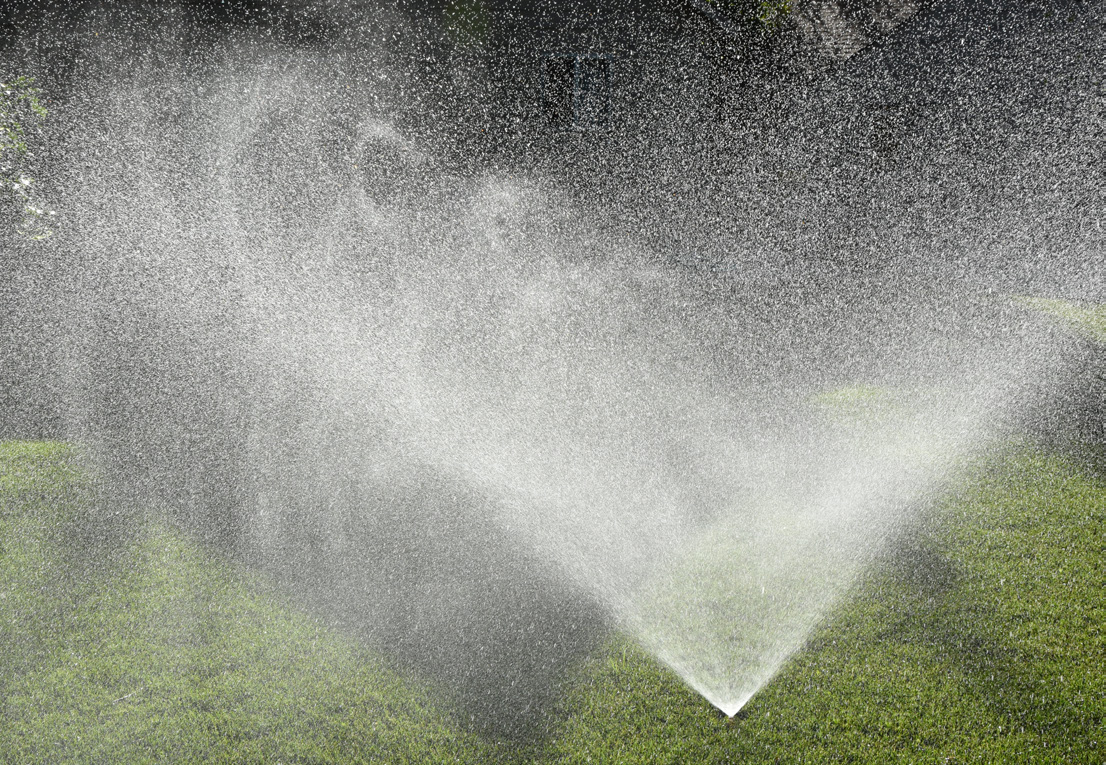
evaporates quickly. This can result in
significant water losses and is fixed by
reducing pressure to manufacturer
recommended levels.
Regardless of the type of irrigation, managers should know the rate of water application for each irrigation zone. Do not assume each zone will have the same application rate especially if varied head types, system pressures and designs are used (Fig. 3).
Long-term Irrigation Management
Once a tree is acclimated to the new, drier landscape, a long term irrigation schedule should be established.
The best method for estimating water needs considers the amount of water evaporating from the soil and transpiring from plant leaves. Combined, these forms of water loss are termed evapotranspiration (ET). The rate of ET is driven by atmospheric conditions (wind, air temperature, radiation and humidity).
While proper irrigation management is both an art and a science, measuring tree water use or irrigation always improves management. An estimate of tree water use can be done using a reference evapotranspiration rate (ETo). For landscapes, this reference is based on the rate of water loss from a uniform cool-season turf (Doorenbos and Pruit, 1977) and is used to estimate the water needs of other plants such as trees.
Typically, the ETo is multiplied by some factor to provide the actual estimated water use. An easy way to use ETo to estimate water use is through the Simplified Landscape Irrigation Demand Estimation (SLIDE) model (Kjelgren, 2016). Using SLIDE, modifiers of ETo are referred to as plant factors (see Table 1).
Table 1. List of plant factors as grouped by plant type.
| Plant Type | Recommended Plant Factor (PF) |
|---|---|
| Turf – Cool Season | 0.8 |
| Turf – Warm Season | 0.6 |
| Woody Plants – Humid Climates* | 0.7 |
| Woody Plants – Dry Climates | 0.5 |
| Desert Plants | 0.3 |
They denote the percentage of water used by various plant types as compared to the reference ETo. In general, trees will use about half the amount of water as the reference. Though based in scientific data, plant factors are generalizations of water use among similar types of plants.
Water needs can vary depending on tree species and their microclimate. It is suggested to start with the recommended plant factor and then make changes if water-related problems are observed. For irrigated areas with mixed plant material, such as two different trees, by default the plant with the highest water needs determines the plant factor of the entire irrigation zone (Fig. 2).
As an example, if a tree is grown in turfgrass the irrigation rate will be based on the grass needs, even though the needs of the tree are less. In this situation, the tree would receive more than enough water from the turf irrigation and would not require any additional irrigation. It is recommended to group plants with similar water needs in one irrigation zone, a tactic known as hydrozoning, so that irrigation is more efficient.
Estimating Irrigation Requirements
Weather data is an excellent indicator of water loss from a landscape. If you adjust that value for the plants used, you can estimate irrigation needs.
Determining the amount of irrigation for an individual tree is done by estimating the irrigation zone water demand (IZWD). The most basic formula for this calculation is: IZWD = ((ETo x PF) - P) x LA x 0.623 where, ETo is a weekly reference evapotranspiration rate, PF is the plant factor (see Table 1), P is any precipitation received during the week, LA is the leaf area (estimated by pi x radius2, height x diameter, or ½ height x diameter for round, columnar, or conical trees, respectively) in square feet, and 0.623 is the conversion factor from inches to gallons of water.
An answer in gallons is most useful when irrigating with drip systems, as the amount of water delivered per emitter is reported in gallons. If using sprinklers, in general the entire zone is irrigated and water is applied in inches as determined by ((ETo X PF)-P). Keep in mind, water needs will also be affected by the density of plants within the irrigation zone. Measuring individual plant size is only necessary when using drip irrigation and if the landscape is less than 80% covered by plants.
Tree irrigation can be done from one to four times a month depending on soil type and local conditions. As an example of tree irrigation, consider the following:
Given a weekly ETo of 2.5, a PF of 0.5, no rain (P=0), and an LA of 200 (8 foot radius2 x pi) an isolated, round tree would have an IZWD of 156 gallons per week: IZWD 156 gal. = ((2.5 ETo x 0.5 PF) – 0 P) x 200 LA x 0.623
Or, for sprinkler irrigation, 1.25 inches per week: IZWD 1.25 inches = ((2.5 ETo x 0.5 PF) – 0 P)
Once the IZWD is known, a sprinkler or drip irrigation system can be used to replace the water. As noted before, each type of sprinkler head delivers water at different rates. If trees are irrigated by overhead sprays, conducting a catch-cup test will give you the most accurate measurement of application rate. In the case of drip systems, the application rate per emitter as reported by the manufacturer should be accurate enough for tree irrigation. Once you know how fast your system delivers water, you’ll be able to set up irrigation run times for each zone.
Multiple Water Source Considerations
When calculating IZWD, it is important to consider other sources of water such as water from other irrigation zones, precipitation, or ground water.
Trees can have extensive root systems that can access water beyond the primary irrigation zone. For example, if a tree is surrounded by turf, even if it is outside the dripline, it is reasonable to assume that the tree will obtain some water from that area. If trees are in their own irrigation zone and have access to these other sources, the irrigation events should be adjusted based on empirical evidence of over or under watering.
If adjustments need to be made, only adjust zones that are specific to the trees that can access additional sources, and remember that irrigation rates are based on the plants with the highest irrigation demand within a zone.
Irrigation Frequency
The frequency of irrigation depends on how much water the soil can hold and the size of the rootzone.
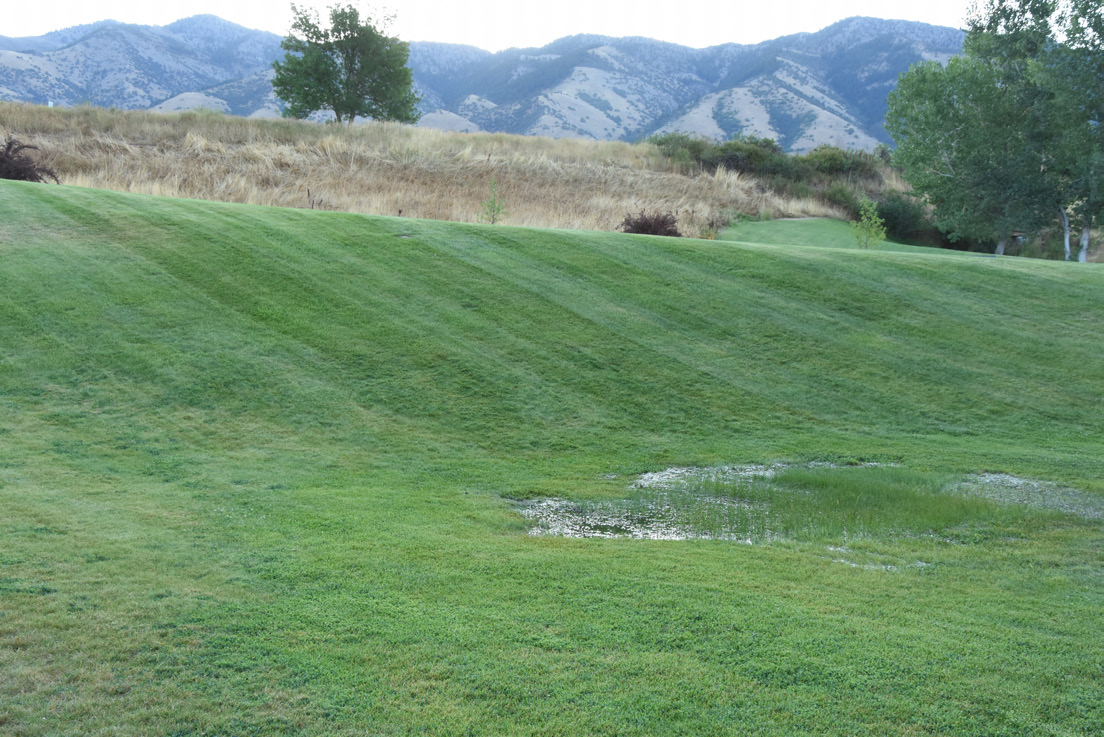
Soil Considerations
Trees with large root systems and finer textured soils (clays) will have greater access to water resources and will notrequire irrigation as often as trees with smaller root systems, or those in coarse textured soils (sands). With fine textured soils it is advisable to break irrigation events into multiple cycles and allow time between for water to soak in (Fig. 4).
To determine the soil type, send a soil sample to a soil testing lab (USU Soil Testing Laboratory). In general, trees perform well when watered one to four times a month. To calculate how much to apply with each irrigation, use the IZWD calculated for the time period. Whether you choose to water one, two, three, or four times a month, will depend on soil type and tree rooting characteristics.
While an effective irrigation plan can assume soils are homogenous across the landscape, changes may need to be made if soil-based problems are observed (such as ponding or dry spots) in specific areas.

absorption rate (upper), and ponding due to over
watering, compaction, or insufficient infiltration
time (lower).
Rootzone Considerations
Mapping the rootzone of a tree is more difficult than determining soil texture. In most cases, tree roots extend out to the dripline and often beyond. This is especially true for columnar trees.
Roots are also found primarily within the top 1-2 feet of the soil profile (Fig. 5). One rough estimate of the radius of root extension for young trees (in inches) from the trunk of the tree can be found by multiplying the trunk diameter (in inches) by 38. Roots of older trees are estimated to extend 2-3 times the distance to the dripline, depending on species, soil type, and space (Day and Wiseman, 2009).
Drip irrigation systems should reach out past the dripline (especially for columnar trees) in order to successfully deliver water where it is needed most.
To encourage deep rooting, it is best to maintain adequate soil moisture 18-20 inches deep within the soil profile. This is done by allowing half of the soil moisture to be used (based on the IZWD) before replacing it through irrigation. The amount of water that can be retained by soils is shown in Table 2. Deep soil moisture can be tested using a soil probe.
Table 2. Available water holding capacity for different soil textures
| Soil Texture | Water Holding Capacity (inches/foot of soil) |
|---|---|
| Coarse sand | 0.25-0.75 |
| Sandy loam | 1.25-1.40 |
| Silt loam | 2.00-2.50 |
| Clay | 1.20-1.50 |
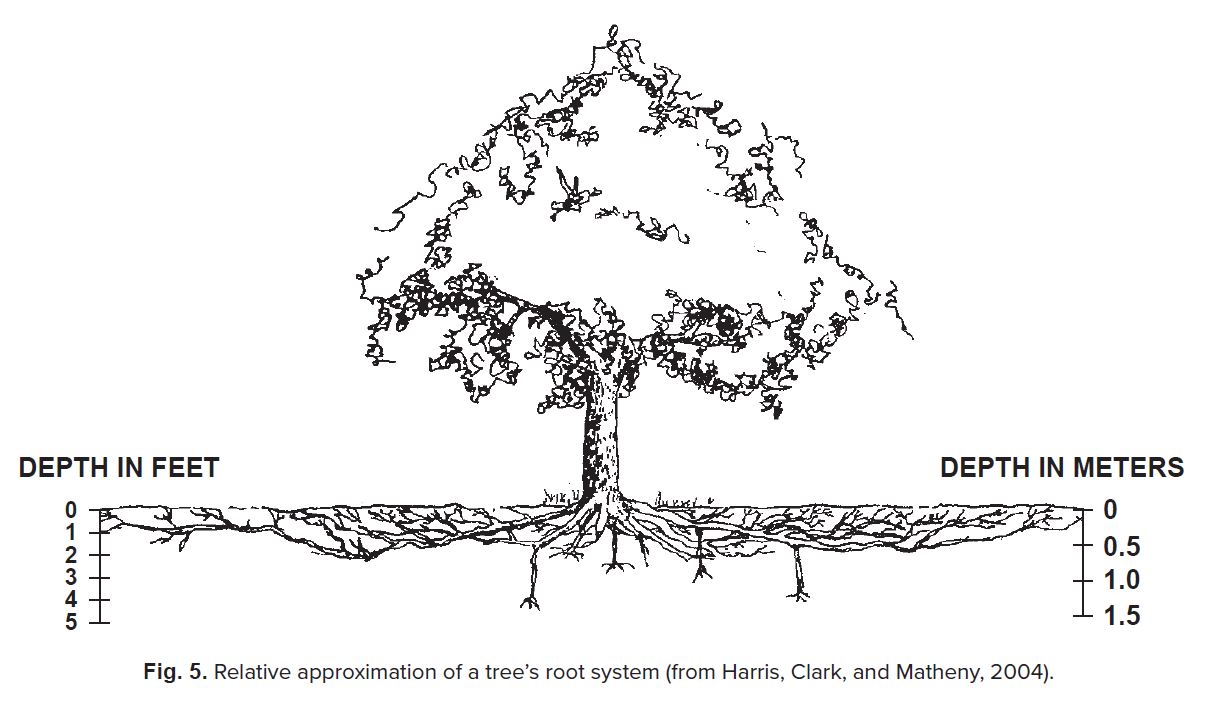
Symptoms of Water Stress
Irrigation scheduling is based on estimates of water loss. Schedules must be verified and adjusted based on tree performance in the landscape.
Soil Considerations
In spite of the best management decisions, it is possible to over or under water trees. Identifying water stress in trees is difficult but important because water stress can create a downward spiral where trees are ever more susceptible to insect pests and extreme weather events (Bréda et al., 2006).
The best way to avoid drought induced damage is through constant monitoring of the landscape. Weekly observations of tree appearance and soil moisture are absolutely critical in preventing water stress during the transition phase, and will help in the development of a practical irrigation schedule based on tree water needs.
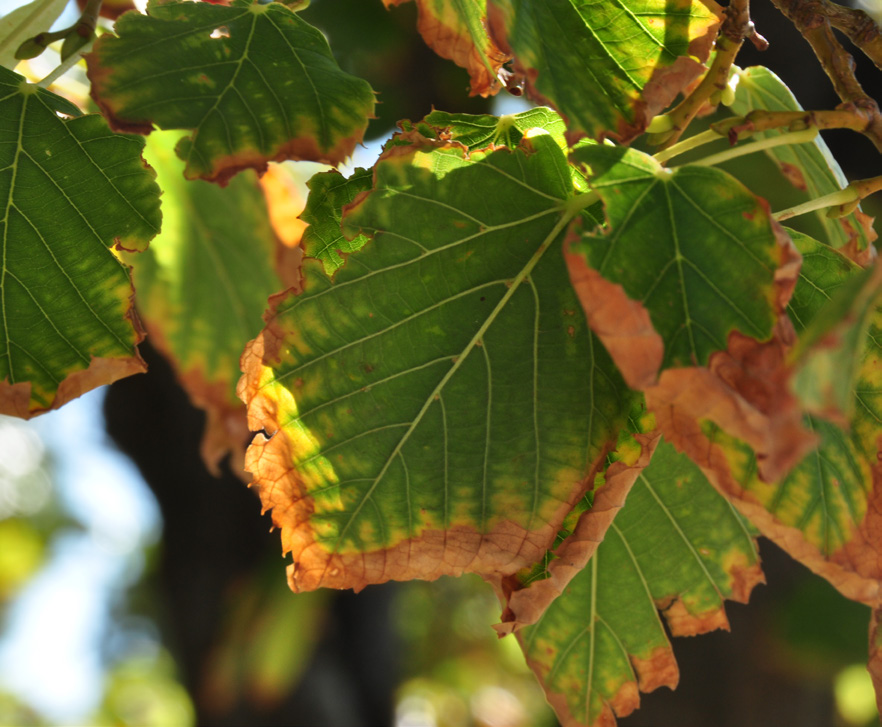
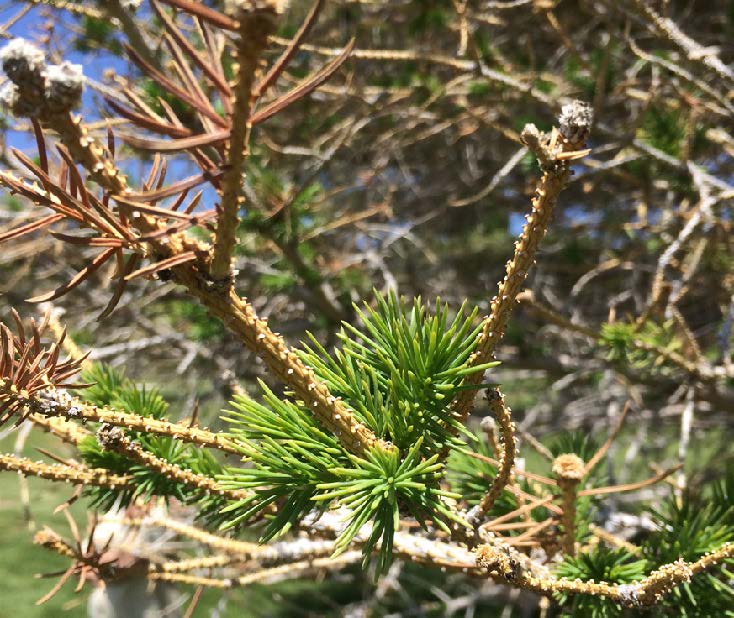

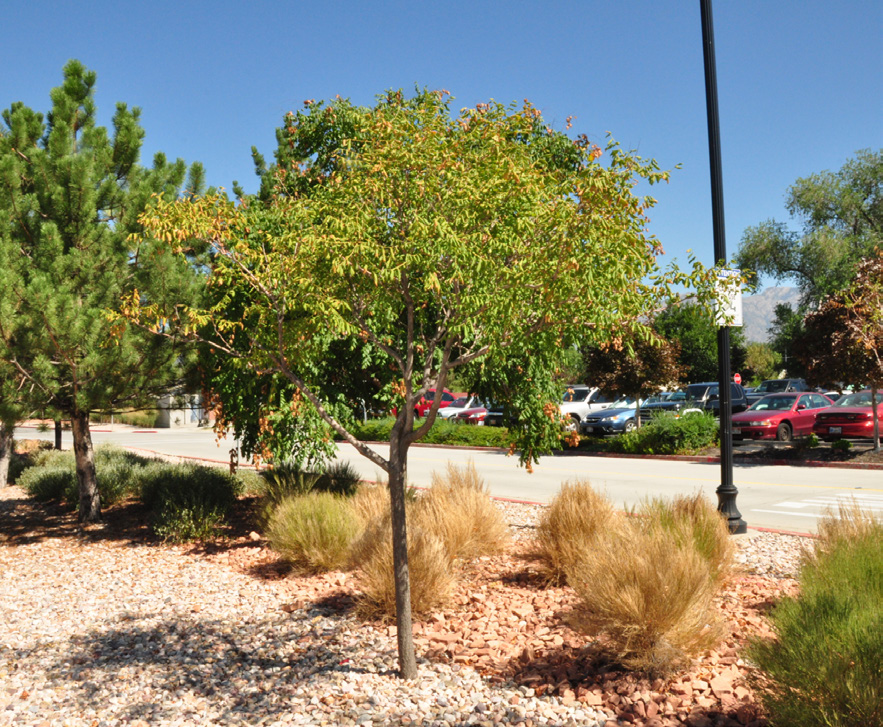
Fig. 6. Clockwise from upper left, leaf margin burn, conifer needle drop, premature leaf senescence, and canopy dieback due to drought stress.
Drought stress in trees can be manifest in several different ways (Fig. 6). Wilting leaves, or limp appearance (easier to see in young trees), early leaf drop, burned leaf edges, reduced shoot growth and canopy dieback are good indicators a tree is under watered.
Drought-stressed trees may also have a sparse canopy and few new branches developing. These symptoms are almost exclusively seen in deciduous trees. For conifers, drought stress is often not noticeable until it is too late to reverse the damage. However, excessive needle drop, halted branch development, or branch die-back can indicate under watering in evergreens.
Over watering trees often produces effects similar to under watering. Tree roots need oxygen to function and when the soil remains too wet, root failure can occur. If a tree begins to wilt, and the leaves become yellow and chlorotic, despite additional water, there’s a high probability the tree is receiving too much water.
If you remain unsure whether symptoms are due to under or over watering, check the soil. Wet soil, or areas of puddling under the tree canopy long after irrigation, indicate excess water is the likely culprit. If over or under watering problems are observed, the best course of action is to alter irrigation frequency, rather than the irrigation amount.
References
- Bréda, N., Huc, R., Granier, A., and Dreyer, E. (2006). Temperate forest trees and stands under severe drought: A review of ecophysiological responses, adaptation processes and long-term consequences. Annals of Forest Science, 63(6), 625-644. doi:10.1051/forest:2006042.
- Day, S.D., and Wiseman, P.E. 2009. At the root of it. Arborist News. Retrieved from www.isa-arbor.com.
- Doorenbos, J., and Pruitt, W.O. (1977). Guidelines for predicting crop water requirements. Irrigation and Drainage Paper 24. 2nd Ed. Rome, Italy: Food and Agriculture Organization of the United Nations.
- Harris, R.W., Clark, R., and Matheny, N.P. 2004. Arboriculture. Integrated Management of Landscape Trees, Shrubs, and Vines. 4th Ed. Prentice Hall, NJ.
- Kjelgren, R., Beeson, R.C., Pittenger, D.R., and Montague, D.T. (2016). Simple Landscape Irrigation Demand Estimation: Slide Rules. Am. Soc. Ag. Biol. Eng. 32:363-378. DOI 10.13031/aea.32.11307.
Authors
Kathryn Johnson, MPSH Graduate student; Larry Rupp Extension Landscape Horticulture Specialist, Utah State University
Related Research


